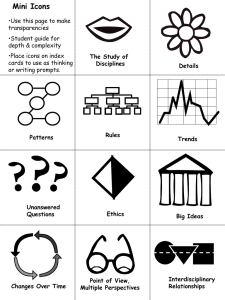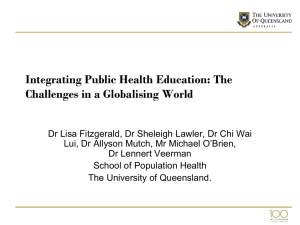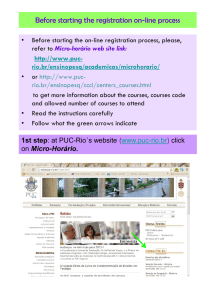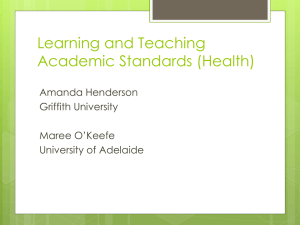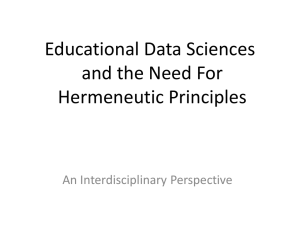PowerPoint Slides
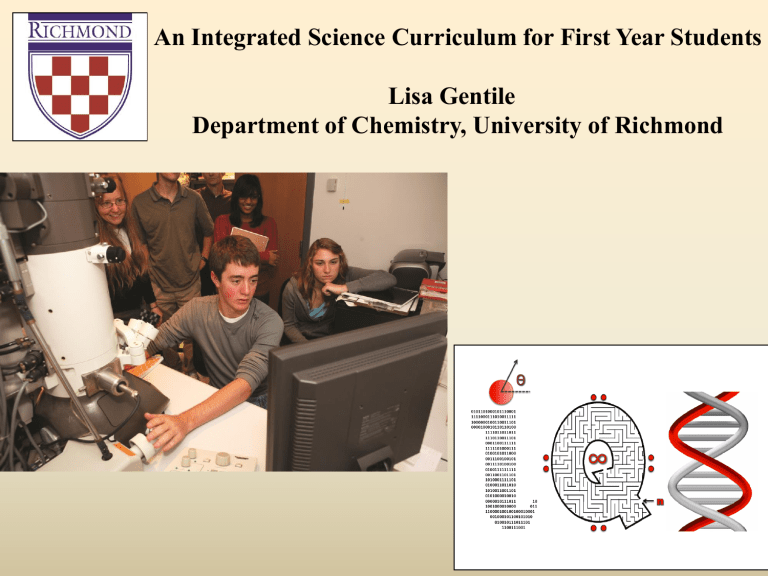
An Integrated Science Curriculum for First Year Students
Lisa Gentile
Department of Chemistry, University of Richmond
Acknowledgments
Back row: Ovidiu Lipan, Krista Stenger, Lisa Gentile, Mike Kerckhove, Doug Szajda, Carol Parish
Front row: Mirela Fetea, April Hill, Kathy Hoke, Lester Caudill, Barry Lawson
UR: Betsy Curtler, Ted Bunn
HHMI: Undergraduate Science Education Award
Integrated Quantitative Science (IQS)
http://iqscience.richmond.edu
/
PKAL- FIDL: http://www.nimbios.org/ifiles/KeckPKAL_IDL.pdf
How do we best prepare our students to work in an interdisciplinary environment?
When a group of faculty met in 2007 to ask that question
UR had strong momentum:
•
Renovated Science Center housing chemistry, biology, physics
•
New science faculty positions
(including 2 “interdisciplinary” science faculty from UR’s first
HHMI grant)
•
Strong science students
•
$900,000 Science Education
Grant #1 from HHMI
•
Success in securing external funding from major programs to increase interdisciplinary work
Teach the material from the first course in each of biology, chemistry, physics, mathematics, and computer science as one, integrated course.
Course team-taught by 5 faculty, one from each discipline.
Includes a hypothesis-driven, discovery based lab and a workshop.
Students then go on to complete a traditional major in any discipline.
Reassigned time to develop/implement/teach the course
Fall
Yr 1 (development):
1 course of 3
Yr 2 (first time teaching):
1 course of 2
Yr 3 : none
Yr 4 : none
Spring
2 courses of 2
Teaching (counts as “3”)
Teaching (counts as “2”)
Teaching (counts as “1”)
IQS Learning Goals:
•
Increased interdisciplinary and disciplinary understanding by students
•
Increased interdisciplinary understanding by faculty, as seen in the quality of integration in lectures and lab
•
Increased number of faculty in STEM disciplines equipped to create courses that draw on concepts from multiple disciplines
•
Increased number of students pursuing cross-disciplinary opportunities at our institution and beyond
•
Increased use by faculty of connections to other disciplines in their discipline-based courses.
Mandatory disciplinary topics in IQS
Discipline
Biology
Chemistry
Computer
Science
Mathematics
Physics
Topic constraints how modern biologists ask questions, scientific methodology, use of tools for observing natural world, quantitative skill building, statistical reasoning, data analysis, scientific communication kinetics, thermodynamics, equilibrium, acid-base chemistry, redox, electromagnetic radiation and Bohr model of atom, quantum mechanics, orbitals and electron configurations, bonding, VSEPR and hybridization, MO theory, Lewis structures, introduction to spectroscopy fundamental object-oriented programming, conditional and looping control structures, arrays, methods and parameter passing, file I/O integration: Riemann sums, numerical estimates, fundamental theorem, substitution integrals; average and instantaneous rates-of-change, the derivative as rate-ofchange, derivative and antiderivative shortcuts, linear approximations, definite integrals vectors, displacement, velocity, acceleration, linear and circular uniform and non-uniform motion, Newton’s laws and fundamental forces in nature, work, energy, energy transfer, linear momentum, oscillatory motion, and rotational motion: cross product, angular kinematics, angular momentum, torque, moment of inertia
Reassigned time to develop/implement/teach the course
Fall
Yr 1 (development): (3)
1 course of 3
Yr 2 (first time teaching) (2)
1 course of 2
Yr 3 : none
Yr 4 : none
Spring
(2)
2 courses of 2
(3)
Teaching (counts as “3”)
Teaching (counts as “2”)
Teaching (counts as “1”)
IQS-1
THEME: Antibiotic Resistance
•Mathematical models of disease spread
•Agent-based simulation models to study disease transmission/ antibiotic resistance
•Conformational flexibility of antibiotic molecule: computer-aided molecular visualization & simulation /VSEPR, VB, MO, energetic analysis
IQS-1
THEME: Antibiotic Resistance
•
Semester-long experiment: What types of bacteria are present in marine sponges (Clathria prolifera) that are resistant to antibiotics?
Creation of sponge stem cell primmorphs and their symbiotic bacteria that were treated with multiple antibiotic regimes, isolation of microbial DNA from primmorphs, amplification and cloning of
16S rDNA, sequencing, bioinformatics: automating comparison with
Genbank and analysis of bacterial DNA sequences (Java program)posters tonight
IQS-2
THEME: Signaling
•
Understanding signaling in the immune system upon activation by an inflammatory response: macrophages activated by LPS to induce transcription of the gene for inducible nitric oxide synthase (iNOS) & analysis by
Western blot and NO assay (Greiss reagents for NO
2
)
•
Use of genetic algorithm techniques to generate potential solutions to the traveling salesperson problem
IQS-2
THEME: Signaling
•
Kinetics of drug binding to wild type and multidrug resistant strains of HIV-1 protease: experimental & computational project
•
MRI (rotational motion). Gyroscopic motion angular velocity, cross product, angular momentum, torque. Resonance, relaxation
•
Brownian motion: classroom, experimental, and simulation approaches
Lessons learned
•
Allow the idea to come from the faculty and to allow us to define what we need to make it work.
•
Allow ample time for both development and implementation
•
Focus on group unity and community building activities
•
Ultimate faculty development
Challenges
• “Full” integration of the material
•
Team teaching with 5 faculty members from different disciplines
•
Small departments- development/early implementation stages
•
Computer science
•
Student selection
Integrated Science (IS) Minor
•
IQS-1 and 2 (or 1 st course in each of the 5 disciplines): 4U
•
IQS Research Training Seminar: 0.25U
•
Research
•
2 x ID course*
1U
2U
•
Senior IS seminar
•
Calculus II
0.5U
1U
*: Currently approved : bio-imaging, math models in biology and medicine, bioinformatics, theoretical/computational chemistry, evolutionary computing, systems biology, structural biology.
Coming soon : epidemiology
IQS Learning Goals:
•
Increased interdisciplinary and disciplinary understanding by students
•
Increased interdisciplinary understanding by faculty, as seen in the quality of integration in lectures and lab
•
Increased number of faculty in STEM disciplines equipped to create courses that draw on concepts from multiple disciplines
•
Increased number of students pursuing cross-disciplinary opportunities at our institution and beyond
•
Increased use by faculty of connections to other disciplines in their discipline-based courses.
Outputs
•
Number of applicants, demographics, number completing course. Year 1: 78, Year 2: 53 (includes physics pre-req)
•
Number of faculty teaching (& length of time) in IQS.
•
Lecture, lab, workshop materials for IQS.
•
Number of students from IQS involved in summer and AY research and
•
Number of students who continue with Research Training
Seminar and IS minor
The first IQS class (2009-2010) vs. the comparison group
IQS (09-10): Comparison:
20 -1 58 +1
17 55 Number remaining at
UR after 2 years
Percentage of students staying for a full time research experience the summer following IQS
100% 9%
61% 22% Percentage of students staying for a full time research experience the
2 nd
summer following
IQS
Percentage of students with credit for academic year research
Percentage of students who took sophomore level research training seminar
100%
79%
25%
0%
Short Term Outcomes
•
Increased appreciation for the value of ID learning
•
Increased disciplinary understanding in each of the 5 disciplines among students who take IQS
•
Increased ID understanding in the faculty as seen by quality/level of integration of disciplines in lectures/labs
Evaluation Questions
1. How effective was IQS in teaching science to studentsboth disciplinary-specific and ID topics?
a. ID: RISC* b. Disciplinary-specific: Next courses in major c. Students continue in the sciences (courses, majors and careers)
*: http://www.grinnell.edu/academic/psychology/faculty/dl/risc
RISC data: IQS students pre-test/ IQS students post-test; all students pre-test/ all students post-test
Student work on problems where no one knows the outcomes
2009-2010 2010-2011
3.00/3.82;
3.06/3.18
2.47/3.94;
2.98/3.21
Students use instruments/materials from other fields of study
Students find similarities/differences between disciplines
2.33/3.94;
2.90/3.07
2.89/4.41;
3.44/3.24
2.79/3.47;
2.88/3.11
3.42/3.72;
3.43/3.33
Students talk with faculty members from other disciplines
2.63/4.29;
3.16/3.12
Students ask questions that implicate more than one discipline in an answer
2.78/4.35;
3.21/3.45
Students create new metaphors, analogies, or models to understand
2.56/4.24;
2.88/3.24
New insights emerge from students considering multiple disciplines
2.50/4.12;
2.79/3.15
3.32/4.00;
3.17/3.22
2.89/3.59;
3.23/3.48
2.68/3.59;
2.85/3.30
2.37/3.50
;
2.77/3.30
RISC data: IQS students pre-test/ IQS students post-test; all students pre-test/ all students post-test
Students present intellectual work in posters
Read a text book
A problem where students have input into process or topic
Students attempt complete understanding of a complex problem
Students use computer modeling of complex systems
Students work on a project or problem entirely of their own design
Students write a research proposal
2009-2010 2010-2011
2.22/4.59;
3.03/3.03
4.56/2.38;
4.31/2.97
2.00/4.64;
3.15/3.85
2.89/4.24;
3.28/3.59
1.22/4.00;
2.15/2.97
2.11/3.40
;
2.87/3.74
1.78/3.50;
2.44/2.96
3.16/3.44;
2.99/3.01
4.11/2.50;
4.28/2.80
2.32/3.31;
3.13/3.80
2.84/3.47;
3.27/3.67
1.53/3.72;
2.12/3.26
1.89/2.31;
2.83/3.71
1.42/1.85;
2.40/3.00
Evaluation Questions
1. How effective was IQS in teaching science to studentsboth disciplinary-specific and ID topics?
a. ID: RISC b. Disciplinary-specific: Next courses in major c. Students continue in the sciences (courses, majors, and careers)
Force Concept Inventory:
basic concepts in Newtonian physics
Gain = (posttest%-pretest%)/(100-pretest%)
62 intro physics courses, 6542 students (Hake, 1998, Am. J. Phys ., 66, 64-74)
*: other goals
Evaluation Questions
1. How effective was IQS in teaching science to studentsboth disciplinary-specific and ID topics?
a. ID: RISC b. Disciplinary-specific: Next courses in major c. Students continue in the sciences (courses, majors, and careers)
Science courses in the first 2 years: the first IQS class (2009-2010) vs. the comparison group
Percentage of students who took a second course in one of the five disciplines
Percentage of students that took a second course in two of the five disciplines
Percentage of students that took a second course in three of the five disciplines
Percentage of students that took a second course in four of the five disciplines
Percentage of students that took a second course in five of the five disciplines
IQS (09-10): Comparison:
17
100%
55
88% (94%)
94% (100%) 73% (78%)
77% (94%) 32% (58%)
24% (44%) 7% (18%)
0% 0%
Mean number of courses the 2009-2010 IQS students took vs. the comparison group
5
4,5
4
3,5
3
2,5
2
1,5
1
0,5
0
IQS
No IQS
BIOL CHEM MATH
Subject
PHYS CMSC
The first IQS class (2009-2010) vs. the comparison group
Percentage of students declaring a major in one of the 5 areas at end of 2 nd
year
Percentage of students declaring a major not in the sciences at the end of 2 nd
year
IQS (09-10): Comparison:
17
94%
55
60%
0% 29%
Evaluation Questions
2. How did teaching IQS change the way in which faculty teach other courses?
a. New cross-disciplinary courses at the upper level are developed and taught: three new interdisciplinary courses have been designed for the IS minor
(systems biology, theoretical/computational chemistry, structural biology) b. Examples, exercises, and problems that emphasize interdisciplinary understanding developed for the
IQS course are used by faculty in traditional discipline-specific courses.
Evaluation Questions
3. Are concepts from each discipline integrated in lectures and labs developed for IQS course?
a. faculty designed and added new integrated projects to the second offering of IQS
Evaluation Questions
4. How effective was the IQS course in training students to problem solve in an ID manner, as seen in their research projects as well as in their future courses?
PKAL- FIDL: http://www.nimbios.org/ifiles/KeckPKAL_IDL.pdf
Acknowledgments
Back row: Ovidiu Lipan, Krista Stenger, Lisa Gentile, Mike Kerckhove, Doug Szajda, Carol Parish
Front row: Mirela Fetea, April Hill, Kathy Hoke, Lester Caudill, Barry Lawson
UR: Betsy Curtler, Ted Bunn
HHMI: Undergraduate Science Education Award

